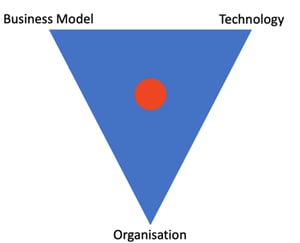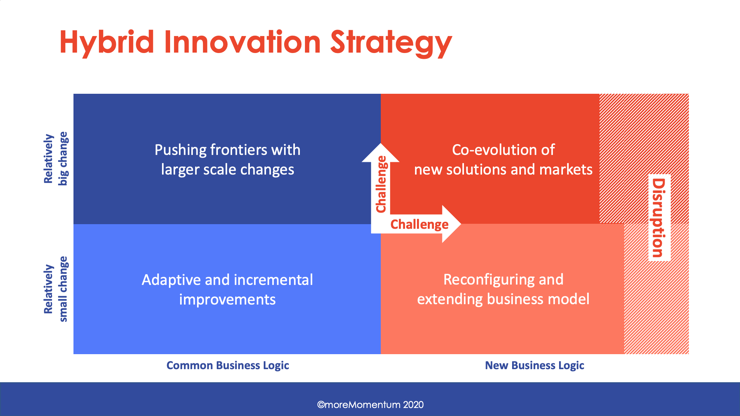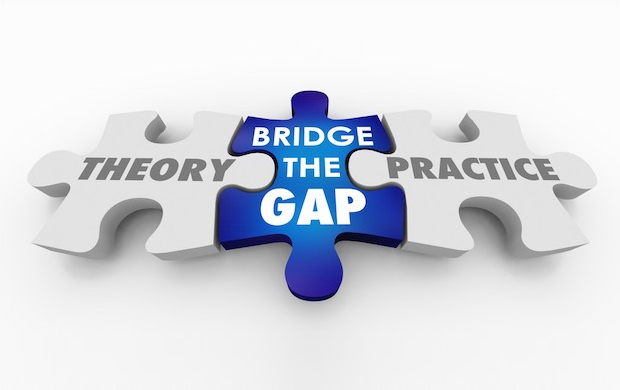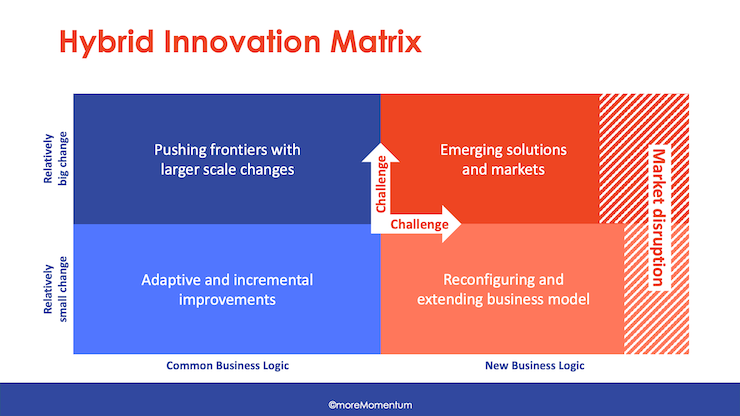3 Steps to Overcome Common Obstacles for Successful Servitization
Servitization, outcome-based services and product-as-a-service are hot topics. However, we see little examples in the industrial sectors. Too often,...

Manufacturers are focusing more on “how" to servitize: How to accelerate servitization and stay ahead of the pack? How to escape from business-as-usual?
For the next years, many manufacturers will focus more on “how” to servitize: How to make these innovations successful? How to accelerate these transitions and stay ahead of the pack? How to escape from business-as-usual? How to prepare the organisation for such journeys?
In this article, I will share an overview of critical challenges and strategies for servitization.
Many manufacturing businesses have made good progress in building a common understanding and commitment to business innovation, including servitization. They have allocated resources and funding for servitization, but are experiencing that servitization is a different ball game from usual innovations like product development, sales improvements, process improvement. They face new challenges, such as:
 We hear and read a lot about new (digital) technologies, new disruptive business models and servitization. Often we see that most of the interest and attention goes towards the technologies. However, the real challenges are about organisational and human aspects:
We hear and read a lot about new (digital) technologies, new disruptive business models and servitization. Often we see that most of the interest and attention goes towards the technologies. However, the real challenges are about organisational and human aspects:
We should have more balance in our focus between the different aspects, including the organisation and business model.
In essence, servitization is all about innovating your business model, particularly when you move beyond purely product related services like maintenance, repair, spare parts and product training. The more our offerings and pricing become more performance-based offerings and the more our solutions are helping clients to improve their processes and outcome beyond the impact of reliable equipment, the more we need to change our value proposition, our brand, our operating model, financial model and go-to-market approach.
Servitization requires us to rethink our value proposition, our target market, our position in the value chain and our position in the competitive landscape. We will be facing new opportunities and new risks.
This also requires us to be open to new thinking, new mindsets and different strategies for innovation and change.
Too often, we see successful strategies for one type of innovation being applied to other types of innovation and therefore fail.
Read more about Service Innovation in our
Ultimate Guide for Service Innovation
I will explain this using the Hybrid Innovation Matrix as a framework. This framework helps to recognise different types of innovation based on respective typical challenges and pitfalls and to choose the best strategy for each type of innovation.
The Hybrid Innovation Matrix differentiates four types of innovation with the respective challenges and strategies along two dimensions.
Along the horizontal axis, we differentiate innovations within the existing business logic from those developing new business logic. In every industry and business we have prevailing business logic, which is a set of common patterns, knowledge, experiences and frameworks of thinking. We use this logic to understand our environment and make decisions. This common business logic defines how we act, learn and change.
Our brains are hardwired to maintain a cognitive framework to rapidly assess our environment, filter information and make decisions. This results in a strong bias towards protecting the established business logic.
Along the vertical axis, we have the relative size of the innovation or change. In the left column, we differentiate incremental improvements from the more radical innovations that push the boundaries. In the right column, we differentiate reconfiguring and extending an existing business model from developing completely new solutions and markets with completely new business models.
I will elaborate on the two quadrants of the Hybrid Innovation Matrix which are most relevant to servitization and briefly describe the other two quadrants.

“Adaptive and Incremental Improvements” is all about continuously optimizing the performance of existing products, services and operations in small steps. Every industry has its common recipe of annual improvement of functionality, performance, speed, cost etc.
Examples include the usual improvement initiatives from departments like product development and marketing
How servitization fits in:
As this is not the quadrant in which servitization takes place, I will not elaborate on this quadrant.
“Pushing Frontiers” is about bigger innovations within the common business logic.
In every industry, we have common pathways of how the performance of products and services develop and how (latent) customer demands evolve. We can learn from the best practices and results from others in our own industry.
Typical examples are:
How servitization fits in:
The early phases of the servitization journey fit in this quadrant. The service offering focuses on managing availability and condition of equipment in a more predictive manner, by investing in data collection, predictive algorithms et cetera.
Challenges:
Innovations in this quadrant often impact a large base of stakeholders in the organisation, advancing the knowledge in various disciplines, and involve serious investments with uncertain bets on the outcome.
A key challenge is to avoid obstacles at all levels in the organisation and a narrow focus on, for example, only products or technology. More specifically, the challenges in the different phases of an innovation process are as follows
During the Discovery Phase:
During the Decision-Making Phase:
During the Implementation Phase:
“Reconfiguring and Extending the Business model” involves a combination of entering new markets, applying new technologies, encountering new competitors and facing new political actors. These are new aspects, different from common and dominant business logic in a business or industry.
Typical examples are:
How servitization fits in:
As you can see from the examples, the more advanced phases of servitization, which extend the value offering beyond product availability or condition, perfectly fit in this quadrant.
Challenges:
The main challenge is to widen a peripheral vision escaping from the established dominant business logic. The challenges in the different phases of an innovation process are as follows:
During the Discovery Phase:
During the Decision-Making Phase:
During the Implementation Phase:
“Co-evolution of new solutions and markets” is about the radically new emerging solutions. Here, we see many different solutions and ideas popping up, while it is still unclear which of the competing alternatives will emerge and become the dominant solution.
Current examples of innovations in this quadrant are renewable energy, data-driven healthcare, mobility (including self-driving cars), Google Maps rapidly pushing away TomTom, and tachographs gradually being replaced by cloud-based applications. Other examples are personal computers displacing mini-computers and digital photography displacing analogue photography.
How servitization fits in:
I will not elaborate any further on this quadrant, as servitization in principle is not about developing these radical solutions. However, in some industries there are actual opportunities and threats in this quadrant, in which servitization could play a role (like the Google Maps versus TomTom).
In Summary – the human factors are critical
Reviewing the challenges described above, it all boils down to the human factor. How do people behave in certain circumstances like pressure to perform, risk, uncertainty, lack of experience or insights and being in a professional network that protects the status-quo.
Therefore, we need to adjust how we innovate, which whom we innovate and how we (do not) steer them.
The challenges I described concentrate on the human factors for successful discovery, decision-making and implementation. They are quite different for each type of innovation in the Hybrid Innovation Matrix, which means we need different strategies to be successful.
I will now describe the best practices for the two types of innovation which are most relevant for servitization.
The name of the game here is “Managing a wider portfolio, including higher risk projects”. The following practices will help accelerate the innovations that push the frontiers – in the three different phases of these innovations.
In general:
During the Discovery Phase:
During the Decision-Making Phase:
During the Implementation Phase:
Be aware for the following common Pitfalls:
The name of the game here is running “Entrepreneurial satellite teams”.
In General:
In the different phases, the following practices will help a lot
During the Discovery Phase:
During the Decision-Making Phase:
During the Implementation Phase:
An increasing number of manufacturing companies commit to servitization and business model innovation and allocate resources to it.
However, many struggle to keep a high pace and escape from business-as-usual. The main reason is, that they have not developed the necessary innovation strategies and approaches to thrive in today’s disruptive industries.
A hybrid innovation strategy, based on the Hybrid Innovation Matrix, focusses on the human factors of your servitization journey and will make the difference between success and failure!
If you want to boost momentum for servitization;
It is a great time to be in manufacturing. We are facing exciting opportunities to make manufacturing a stronger backbone of our service-oriented economies. We have a unique opportunity to make manufacturing a great place to work and to invest in.
Check out the upcoming Service Transformation Summits:
Subscribe for the our Impulse Letter
With regular updates about service news, trends and best practices.

Servitization, outcome-based services and product-as-a-service are hot topics. However, we see little examples in the industrial sectors. Too often,...

Different types of innovation require different strategies to succeed. But there is no single silver bullet. We need frameworks and guidelines to...

Launching new advanced services is innovating your business model. This requires internal momentum to monetise these services and data-driven...